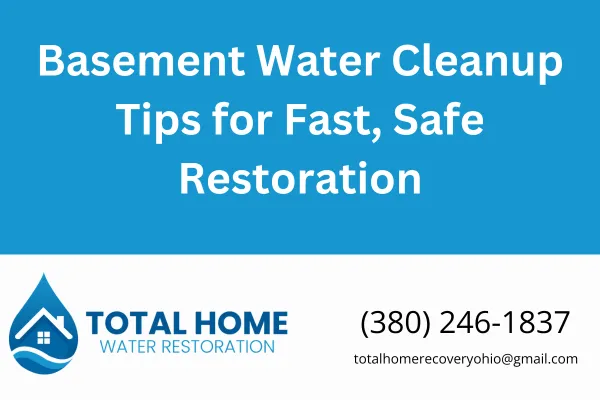
Basement Water Cleanup Tips for Fast, Safe Restoration
Basement Water Cleanup Tips for Fast, Safe Restoration
If you've walked into your basement and found standing water, you’re not alone. Whether it’s from a busted pipe, heavy rains, or a failed sump pump, a wet basement needs attention—fast. At Total Home Water Restoration, we’ve seen it all, and we’re here to walk you through what to do right now to protect your home, your health, and your wallet.
Step 1: Stay Safe
Before you grab a mop, take a breath—and a look around.
Turn off electricity to the basement if water is near any outlets, appliances, or your breaker box.
Watch out for slippery stairs or tripping hazards.
If the water looks dirty or smells foul, don’t touch it—you may be dealing with sewage or contaminated groundwater.
⚠️ If in doubt, stop and call us at 380-246-1837. We’ll walk you through it or send a crew over.
Step 2: Find the Source and Stop the Flow
You can’t clean it up if it’s still coming in.
Check for plumbing leaks, burst pipes, or overflowed water heaters.
If it's storm-related, look for drain backups or seepage through the walls or floor.
Shut off the main water supply if needed.
Tip: Take pictures of the damage for insurance—before you start cleanup.
Step 3: Start Removing Water (If It’s Safe)
If the water is clean and you feel confident, act fast.
Use a wet/dry vac or sump pump to pull up water.
Towels or mops can help with smaller puddles.
Get fans and dehumidifiers running ASAP.
The longer the water sits, the more damage it causes—especially to drywall, insulation, wood, and flooring.
Step 4: Remove Wet Items
Pull up any wet carpets, rugs, or boxes.
Move furniture and anything porous out to dry.
Don’t try to save soggy drywall or insulation—they’ll likely need removed and replaced.
Remember, Ohio code (based on IRC Section R322.1.6 and IICRC S500) recommends removing water-damaged materials within 24–48 hours to prevent mold growth.
Step 5: Check for Mold and Damage
Even if the water’s gone, the real damage might be hiding.
Look for musty smells, wall discoloration, or peeling paint.
Wood that’s warped or soft might need replaced.
Mold can start growing in just 24 hours if conditions are right.
This is where a professional assessment can save you thousands down the line. Our certified team follows IICRC S520 standards for mold remediation and can help you decide what stays and what goes.
When to Call the Pros
Call us if:
Water is contaminated (sewage, chemicals, or floodwater)
You have more than a few inches of standing water
The leak has been ongoing or hidden for a while
You see signs of mold or structural damage
At Total Home Water Restoration, we do more than just dry out basements—we make sure it’s done right, by the book, and with your safety in mind.
FAQs
How long does it take to dry a flooded basement?
It depends on how much water was present and what materials were affected, but typically 3 to 7 days with professional equipment.
Is basement water cleanup covered by insurance?
If the cause was sudden and accidental (like a burst pipe), usually yes. Floodwater from outside? That may need separate flood coverage. We help with documentation either way.
Do I need to replace the drywall?
If it got wet past the baseboard, yes. Drywall and insulation trap moisture and grow mold fast.
From disaster to done right—we fix it like it’s our own home.
Contact Total Home Water Restoration
📍 4141 Hoover Rd, Grove City, OH 43123
📞 380-246-1837
